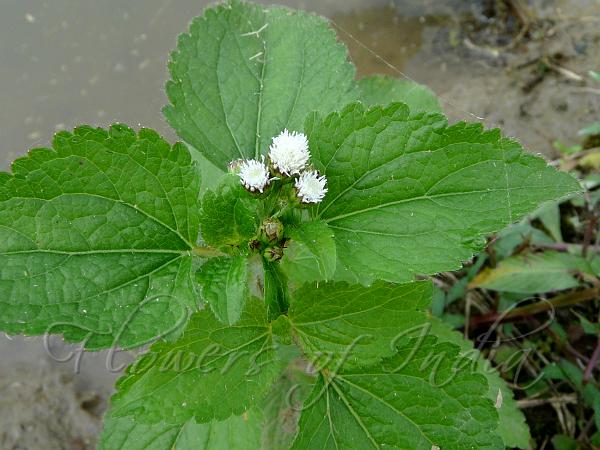|
| Goat Weed |
|

|

| File size | 714922 |
| Original date | 11/7/19 1:21 PM |
| Resolution | 2060 x 1545 |
| Flash | Flash did not fire, auto |
| Focal length | 4.6mm |
| Exposure time | 1/125s |
| Aperture | 4.0 |
| Focus Distance | |
| Metering Mode | Multi-segment |
| Camera make | Panasonic |
| Camera model | DMC-FZ18 |
| Sensor type | OneChipColorArea |
|
|
|
Photo: |
Botanical name: Ageratum conyzoides Family: Asteraceae (Sunflower family)
Goat weed is a common tropical annual herbaceous weed.
It is an erect softly hairy annual plant which grows
up to a height of 2.5 feet. Oppositely arranged leaves are ovate to
lance-like, coarsely rounded, and have toothed margin. Numerous pale blue or
whitish flower-heads are 6 mm across, often forming dense domed to flat-topped
clusters in leaf axils or end of branches. Flowers most of the year.
The stem is often red and has long white hairs. The weak aromatic unpleasant
smelling leaves are also covered with fine hair.
The dark seeds have scales and ends in a needle-like shape.
Goat weed is native to tropical America, but widely naturalized world over.
In India it can be seen in the Himalayas, up to 2000 m altitudes.
Medicinal uses: In alternative medicine, ageratum is used against epilepsy and wounds, also
used as an insect repellent. In China it is used to treat a variety of
conditions, including common colds, headaches, boils, eczema,
bleeding wounds, and burns.
In alternative medicine, ageratum is used against epilepsy and wounds, also
used as an insect repellent. In China it is used to treat a variety of
conditions, including common colds, headaches, boils, eczema,
bleeding wounds, and burns.
Medicinal uses:
 In alternative medicine, ageratum is used against epilepsy and wounds, also
used as an insect repellent. In China it is used to treat a variety of
conditions, including common colds, headaches, boils, eczema,
bleeding wounds, and burns.
In alternative medicine, ageratum is used against epilepsy and wounds, also
used as an insect repellent. In China it is used to treat a variety of
conditions, including common colds, headaches, boils, eczema,
bleeding wounds, and burns.| Identification credit: Tabish, Nidhan Singh | Photographed in Moirang, Manipur & Morni Hills, Haryana. |
• Is this flower misidentified? If yes,